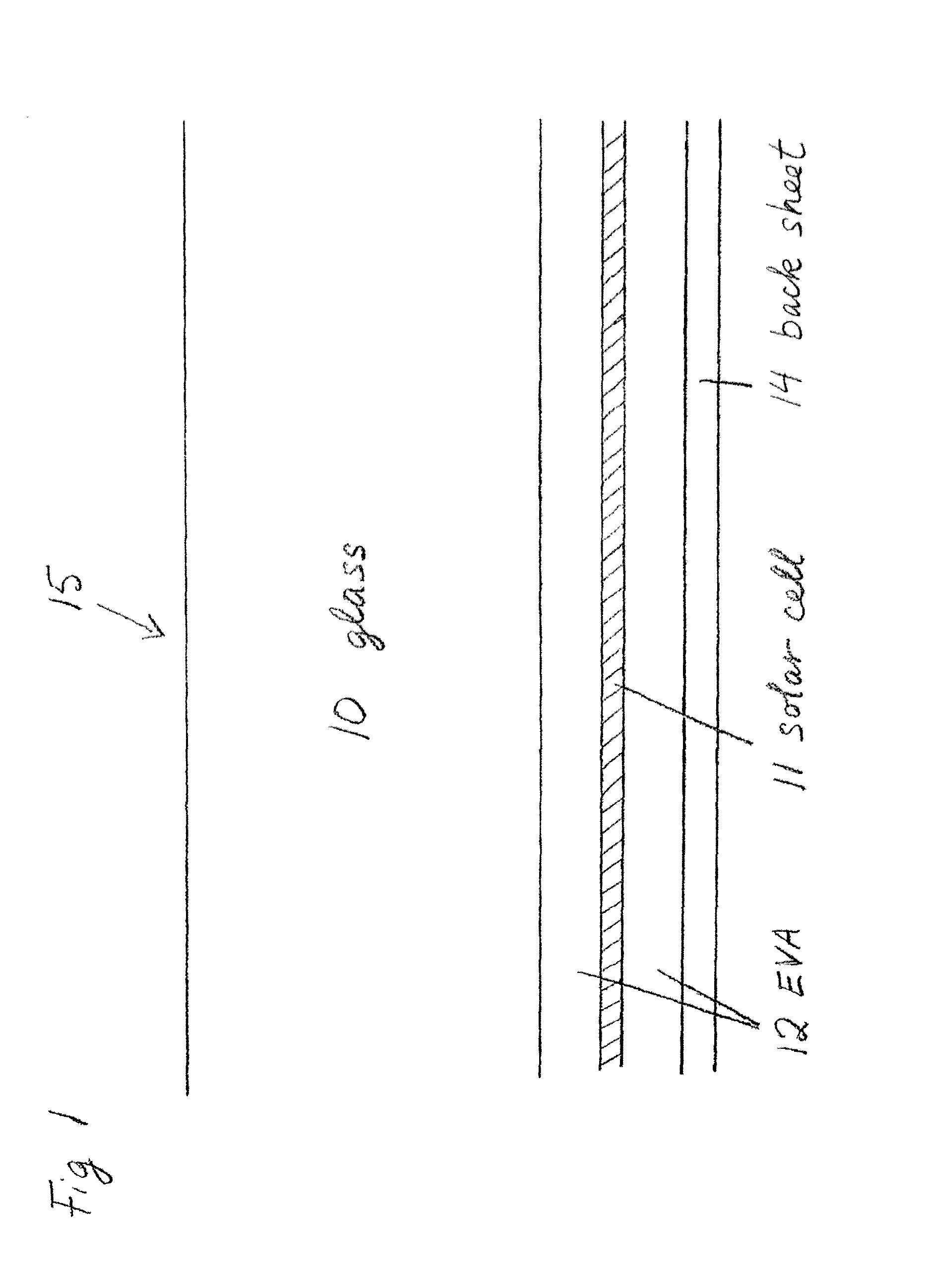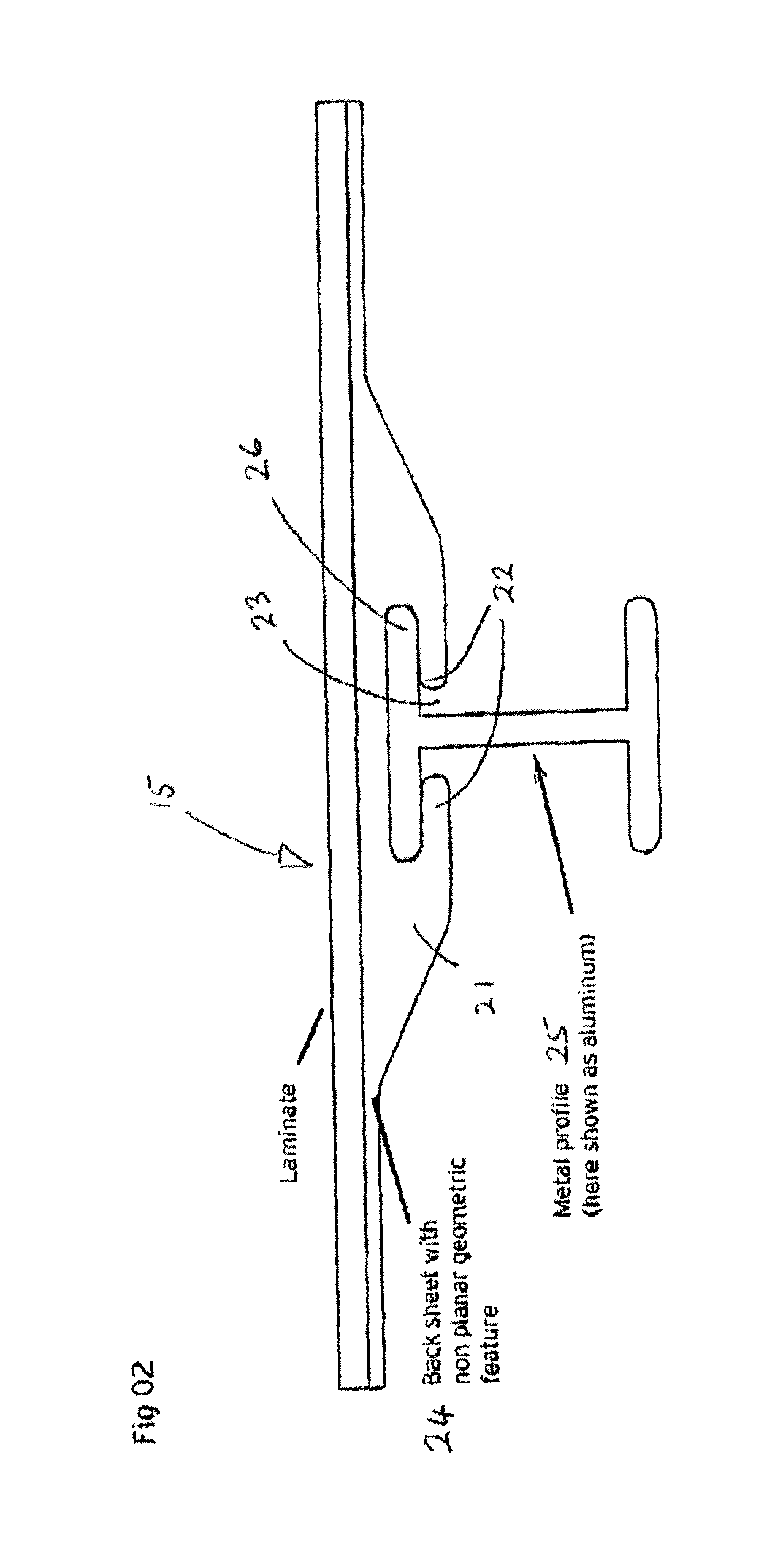Photo voltaic generator panel, method and system
a generator panel and photovoltaic technology, applied in the direction of solar heat collectors, solar heat collector mounting/support, light and heating apparatus, etc., can solve the problems of high transportation and final installation cost, time-consuming method of fixation, disadvantage of a higher weight, etc., to achieve easy, fast and robust mechanical joining, the effect of maximizing the use of the insolation area
- Summary
- Abstract
- Description
- Claims
- Application Information
AI Technical Summary
Benefits of technology
Problems solved by technology
Method used
Image
Examples
first embodiment
[0082]FIG. 2 shows the invention. The laminated panel 15 has a back sheet 24 which is formed integrally with an attachment feature 21. The feature 21 stands out slightly from the back sheet (e.g. by between 1 mm and 25 mm), and has two lips 22 arranged to limit access to a central slot 23 (recess). This figure shows a support formed as an aluminum ‘I’ beam 25. The upper flange 26 of the ‘I’ beam 25 fits into the slot 23. (The configuration of the slot 23 can be designed specifically to accept standard sized flanges 26.) It is important that the flange 26 fits securely into the slot 23. The ‘I’ beam 25 in this case forms part of a support structure (not shown but lying beneath the ‘I’ beam) for the panel 15. The attachment feature 21 permits easy on-site assembly of the panel 15 onto the support structure which may be a roof, tracker or ground mounted structure. Roofs may have flat or corrugated surfaces, tiles or shingles. Additional features may be added to prevent loss of the pane...
second embodiment
[0085]FIG. 3 shows the invention.
[0086]In this case the planar back sheet is wholly incorporated into the laminate 15A. An attachment feature 31 is joined to the back sheet 34 with an adhesive 37. The configuration of the attachment feature 31 is similar to the feature 21 shown in FIG. 2. Lips 32 limit access to a central slot 33, which on assembly fits around the upper flange 36 of an ‘I’ beam 35. Whilst an adhesive may be used to bond compatible polymers it also provides advantages in bonding polymers which may not be directly compatible for welding purposes.
[0087]FIGS. 4a and 4b show rear views (non-insolation side) of panels according to the invention.
[0088]FIG. 4a shows two attachment features (such as 31 in FIG. 3) bonded in spaced parallel relationship to the back sheet of a PV panel 15, and FIG. 4b shows four similar attachment features bonded to a similar panel. The cross sectional shapes of the attachment features and their relationship to the panel as a whole are shown cl...
third embodiment
[0098]FIG. 9 shows the invention. A glass superstrate overlies a PV cell which in encapsulated in a layer of EVA. Back sheet 84 is laminated with the glass and EVA layers to form an integral laminate panel. An attachment feature 83 is bonded to the outer side of the back sheet with adhesive 86. In this case the attachment feature has opposed slots 87 in its outer surfaces, so that engagement can be effected by two inwardly facing opposed edges 88. The edges 88 are formed on an open ‘C’ profile steel support member 89. The edges are the opposed ends of the open profile, and the upper faces of that profile lie directly below portions of the attachment feature 83, so to give direct support to the laminate above the adhesive 86.
[0099]FIG. 10 shows a forth embodiment of the invention. This is similar to the third embodiment, except that the upper faces of the attachment feature 93 are welded directly to the back sheet 94 at a welded joint 96. As with the third embodiment, the edges 98 of...
PUM
 Login to View More
Login to View More Abstract
Description
Claims
Application Information
 Login to View More
Login to View More - R&D
- Intellectual Property
- Life Sciences
- Materials
- Tech Scout
- Unparalleled Data Quality
- Higher Quality Content
- 60% Fewer Hallucinations
Browse by: Latest US Patents, China's latest patents, Technical Efficacy Thesaurus, Application Domain, Technology Topic, Popular Technical Reports.
© 2025 PatSnap. All rights reserved.Legal|Privacy policy|Modern Slavery Act Transparency Statement|Sitemap|About US| Contact US: help@patsnap.com



